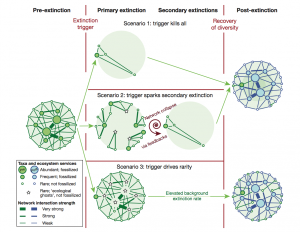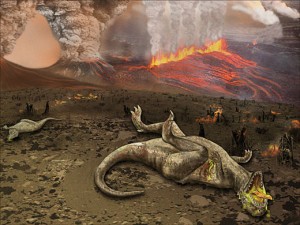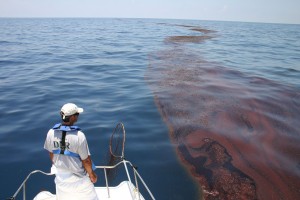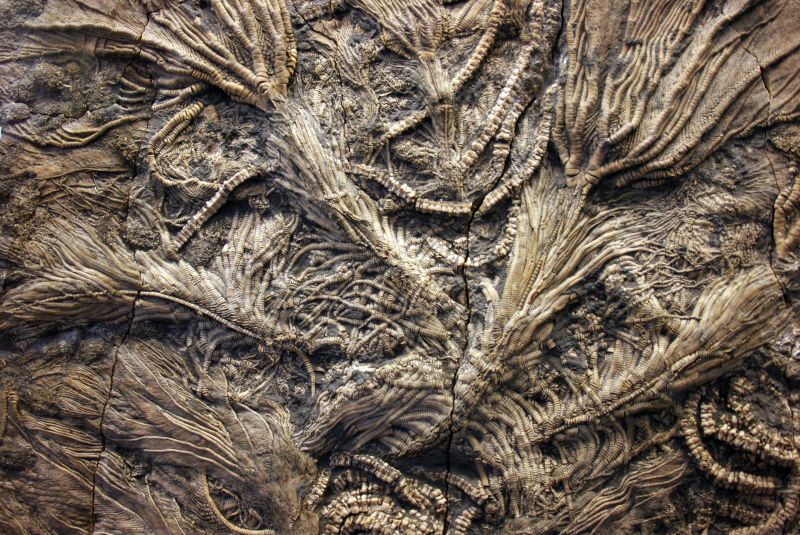From the asteroid strike that ended the reign of dinosaurs to the question of whether we are living through a sixth mass extinction today, mass extinctions have captured the public imagination. Now, a group of scientists is challenging how mass extinctions are interpreted, and they argue for species rarity as a more useful and accurate way to measure ecosystem collapse.
Comparing the events of today to distant events in evolutionary time is difficult. Scientists today can only attempt to piece together the story of how species and their environments changed over time using the fossil record. These records form over hundreds of thousands of years as marine organisms die, fall to the ocean floor, and accumulate in layer upon layer of rock. They see some layers with many species and others with very few, and they infer that the layers where many species are suddenly lost from the rock record bespeak of times of rapid and rampant ecosystem collapse called mass extinctions.
But since human history is only a split second in fossilized time, the high extinction rates of today may not necessarily correspond to species loss on the scale of past mass extinctions. The notion of mass extinctions, seared into the public consciousness by paleontologists Jack Sepkoski and David Raup in their 1982 landmark paper, does not capture nuances of biodiversity crises past or present.

Species become rare before they go extinct. We see species becoming rare today. The researchers, including lead author and Yale assistant professor of geology Pincelli Hull and Smithsonian Institution curator Douglas Erwin, now propose species rarity as a reliable way to measure the extent of modern ecological crises.
But the researchers question whether present biodiversity changes necessarily constitute a sixth mass extinction. We need to change how we compare ecological changes today to the five past mass extinctions to address the question.
Even so, Simon Darroch, assistant professor at Vanderbilt University, and another author of the paper, said we should be worried about the rapid decline of marine species such as clams and corals. The Elkhorn coral, for instance, used to be the most abundant species in the Caribbean 3,000 years ago. Now, although not extinct, the species is rare.
Comparing then and now
Hull had been frustrated for years by the idea of the “sixth mass extinction.” After researching the catastrophic K-T mass extinction that wiped out most dinosaurs 65 million years ago, Hull deeply questioned whether scientists could compare present ecological changes to past mass extinctions using information preserved in fossils. She was skeptical of comparing information across vastly different time scales. “The way extinction is preserved in the fossil record is so different than the way that we see it today,” Hull said.
Extinction rates can appear to be low in the fossil record due to its preservation of long time intervals, according to Hull. Whereas scientists use fossil records — which represent tens or hundreds of thousands of years in a couple of centimeters — to estimate extinction rates during past mass extinctions, scientists measure current rates on much shorter time intervals.
Hull explained the fallacy using an analogy. Imagine we h
ave a man crossing the street in a minute. A clock that measures time in seconds would indeed show the man crossing the street in a minute, but another clock that measures time in years would tell us that the same man crossed over the span of a year. No wonder scientists using fossil records come up with past extinction rates 10 times lower than present measurements — and smear out sudden, dramatic extinction events.
Darroch likewise said the fossil record was an amazing research tool, but it averaged processes over long intervals without really capturing ecosystem collapse. According to Erwin, the fossil record was not good enough to resolve events other than which species were absent or present during past mass extinctions, and he said scientists had not paid enough attention to other ecological factors.

In a workshop on extinction at Arizona State University’s Institute of Human Origins, Hull, Darroch, and Erwin asked how scientists could better compare present ecological processes with past mass extinctions using the fossil record. They discussed the issue over lunch. By that evening, the team had drafted the paper that was not exactly a study or review, but an idea — about how scientists can compare past mass extinctions and present ecological changes using species rarity instead of extinction rates. “By measuring rarity, we actually do get rid of that problem of smearing things out,” Hull said.
Changing scenarios
The researchers outlined three scenarios for how ecosystems may change during mass extinctions, in order to recapture some of the nuances lost in the fossil record.
In the first scenario, ecosystems collapse instantaneously. A trigger, such as the asteroid impact that hit Earth during the K-T extinction, causes most species to become extinct within a few hundred years. Scientists often assume this first scenario to be the case when they see sudden disappearances of species from the fossil record.
In the second scenario, mass extinction is delayed. After a trigger causes some species to become extinct, the ecosystem changes in such a way that it cannot sustain itself. The initial extinctions lead to more extinctions, which lead to even more extinctions, and the vicious cycle eventually leads to mass extinction.
But the researchers were more interested in the third scenario, which does not assume species go extinct when they disappear from the fossil record. The trigger in this scenario does not lead to any extinctions; rather, it leads to some species becoming rare. If those species had once been common and important in the ecosystem, their rarity increases the risk of total ecosystem collapse. This scenario is called “elevated extinction risk.”
So far, scientists cannot distinguish between the scenarios in the marine fossil record. Hull and her team came up with these hypotheses about how ecosystems change in mass extinctions, but others must test them. Darroch has taken up some of the challenges by designing a model to test how changes in the ecosystem affect fossils. By distributing species across a map and asking what happens when common species become rare and when rare species become extinct, he can see how much fossils preserve. The tests have gone on for about four months, and Darroch anticipates four more — not to mention the years of further work he and other scientists must do to answer questions about the ways in which mass extinction scenarios are playing out in the world today.
Drawing the line
The Elkhorn coral — once common, now rare — provides one clue that ecosystems face a greater risk of mass extinction in the present day.
Hull and other researchers may object to the term “sixth mass extinction” because it implies that scientists have made a reliable comparison between past mass extinctions and present ecosystem conditions using fossil records. But the researchers do not deny that we are living through a time of massive ecological change — caused mainly by us.

In their paper published in Nature in December 2015, the team members describe how marine species like clams and coral have declined in absolute numbers and geographic area due to human activities such as overfishing and pollution. The species have become what researchers call “ecological ghosts,” no longer performing their function in the ecosystem. Elkhorn corals, for example, no longer provide a home for fishes.
Based on these observations, extinction on a greater scale suddenly seems more likely. Hull sees the intensive, destructive activity of human beings as a thin line in the fossil record — similar to the dark brown line between the Cretaceous and Paleocene periods caused by the K-T extinction. But she objects to another idea regarding how humans are impacting the planet. “I don’t think we’re entering the Anthropocene,” Hull said, referring to the idea that human activity is forcing the planet into a new geologic period. “I think that what we’re doing will end up looking like the boundary between two different layers.”
Interpreted in one way, Hull predicts an apocalyptic future. She claims that human beings cannot last another geologic period, tens of thousands of years, if they keep up their destructive activities. But under a different light, Hull is optimistic. She said that on “good days,” usually when she is at Yale, she believes humans can make it across the line, head off mass extinction, and enter a period quite unlike the Anthropocene.
Erwin agrees with Hull that defining a new geologic era centered on humans would not save any species from becoming rare or extinct. But Darroch said the concept was a good public relations tool. He urged us to view modern ecological changes from a new perspective. “If you were an alien investigating a hundred years from now, and you were to look at the rock record, all the stuff that we’re doing will be preserved in a thin smear,” Darroch said.
A thin smear, representing a few hundred years of human activity and massive ecological change, may be either a starting line or a finishing line — depending on our perspective on ecological crises.
Extra Reading:
Crutzen, P. J. & E. F. Stoermer (2000). “The ‘Anthropocene'”. Global Change Newsletter 41: 17–18.
About the Author:
Amanda Mei is a sophomore Environmental Studies major in Berkeley College. She is a former Layout Editor of the Yale Scientific Magazine interested in the relationships between human beings, wildlife, and the environment.
Acknowledgements:
The author would like to thank Pincelli Hull, Simon Darroch and Douglas Erwin for their thoughtful interviews, as well as their dedication to understanding ecosystem dynamics in present and past ecological crises.

